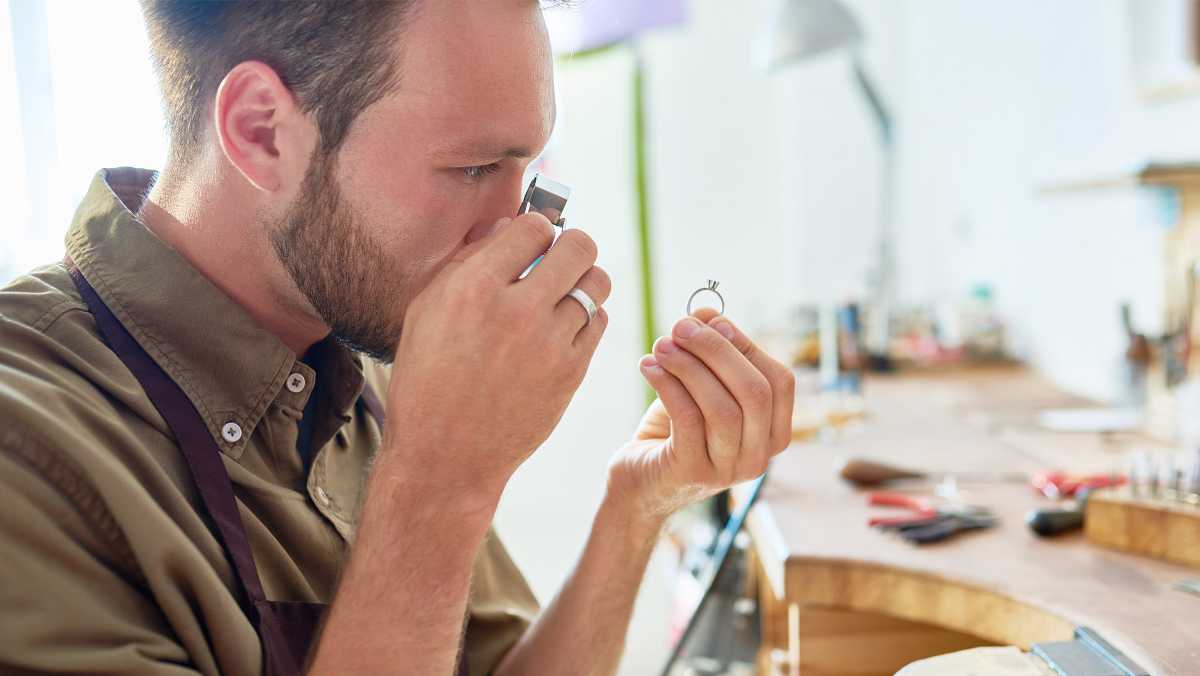Importing jewellery

- The basis
- Edited 28 November 2025
- 7 min
- International
Jewellery is made all over the world. Most gold and silver jewels and jewellery with natural gemstones are imported from non-EU countries. As an importer you have to comply with several rules and requirements.
Do you have plans to import jewellery with your business? There are several product requirements to keep in mind. Jewellery comes in all sorts of shapes, sizes, and colours, from rings and bracelets to necklaces and earrings. Jewellery can be made of precious metals, base metals, or other materials such as textile, leather, and plastic. Did you know that jewellery made of precious metals has to bear recognised hallmarks? This article explains why and outlines other important factors to keep in mind.
- Product requirements
- Product liability
- Importing goods from EU countries
- Importing goods from non-EU countries
Product requirements
You should only offer products on the European market that are safe for . The European Product Safety Regulation (EU) protects consumers from unsafe non-food products. For example, it must be clear where your products come from. And you must use a quality system to guarantee the safety of the products you sell. The new European law is also known as the General Product Safety Regulation (GPSR). The GPSR is about general product legislation. In addition to requirements for general product safety, there are there are special product requirements for jewellery.
Precious metal jewellery and hallmarks
Consumers must have confidence that jewellery made of precious metals is genuine and that the purity level of the precious metal used in their jewellery is accurate. Therefore, you may only place jewellery made of gold, silver, or on the Dutch market if they feature at least two hallmarks: the fineness mark and the sponsor’s mark. The following articles of jewellery are exempted:
- jewellery with a gold content of less than one gram.
- jewellery with a silver content of less than eight grams.
- jewellery with a platinum content of less than half a gram.
The fineness mark indicates the type and purity level of the precious metal, while the sponsor’s mark indicates who is responsible for placing the precious metal jewellery on the market.
In the Netherlands, the assay offices and Edelmetaal Waarborg provide precious metal jewellery with hallmarks. Do you import precious metal jewellery from an EEA country and does the jewellery bear hallmarks from an approved assay office from an EEA country? You do not need to have a Dutch assay office inspect the jewellery and apply hallmarks. The approved assay office in the other EEA member state must be independent and government-designated and accredited.
Imported jewellery bearing Common Control Marks (CCM) does not have to be inspected by an official assay office. CCM are special hallmarks that are accepted in the signatory countries of the Hallmarking , which includes the Netherlands. This convention is also known as the Vienna Convention.
If you import precious metal jewellery into the Netherlands from a non-EU country and the jewellery does not bear CCM or hallmarks recognised in the Netherlands, you are required to submit the jewellery to WaarborgHolland or Edelmetaal Waarborg Nederland for inspection. If you fail to do so, you may not sell the jewellery in question. The RDI (Dutch Authority for Digital Infrastructure, in is responsible for checking whether precious metal jewellery has the required hallmarks.
Restrictions on chemicals
Jewellery may contain chemicals that are harmful to human health. Because jewellery comes into contact with the skin, it is subject to restrictions on chemicals under the European regulation. There are specific rules for heavy (in Dutch) such as lead, cadmium, and nickel, as well as substances such as chromium-6 (in Dutch) in leather and azo dyes in leather or textiles. These rules also apply to leather or textile jewellery.
REACH imposes responsibilities on:
- companies that import products from countries outside the EEA, referred to as importers in the REACH regulation.
- companies that import products from countries belonging to the EEA, referred to as distributors in the REACH regulation.
The Netherlands Food and Consumer Product Safety Authority () checks whether jewellery complies with the safety requirements.
Endangered animal and plant species
CITES is short for the Convention on International Trade in Endangered Species of wild flora and fauna, an agreement signed by 183 countries to prevent the extinction of endangered plant and animal species. applies to jewellery that contains endangered plant and animal species. The commercial trade of some species of endangered animals and plants is banned altogether, while other species are subject to import restrictions.
Cat and dog fur and seal products
Jewellery placed on the EU market may not contain cat or dog . Importing or marketing jewellery containing seal is also prohibited, with the exception of seal products sourced from traditional hunting by Inuit and other indigenous communities. Specific conditions do apply.
Useful agencies and authorities
The following agencies provide information on product requirements and import regulations.
CBI
The Centre for the Promotion of Imports from Developing Countries (CBI) helps exporters from developing countries export goods to the European market. CBI's website provides useful information on the European product requirements for jewellery.
European Commission
On its Access2Markets portal, the European Commission provides information on import regulations for products imported from outside the EU. You can find guidance on how to use the portal on the website. On the chemicals page, you will find a list of obligations linked to the restrictions on chemicals in jewellery, textiles, and leather.
REACH Helpdesk
The REACH Helpdesk (in Dutch) answers questions about the REACH regulation.
VeiligheidNL and RIVM
VeiligheidNL and the National Institute for Public Health and the Environment (RIVM) provide information on the presence of chemicals in (in Dutch).
Product liability
You are legally a producer if you:
- import jewellery from countries outside the EEA.
- purchase jewellery within the EEA and attach your own label or brand name to it.
If you are a producer, you are liable for damage caused by a defect in your products. Read more about the product safety requirements for
Importing goods from EU countries
There is free movement of goods in the EU, which means that you do not have to pay import duties when importing jewellery from another EU member state. You do not have to declare these goods to Dutch Customs, but they are subject to VAT.
VAT
Your supplier in the other EU country will usually charge 0% VAT if you pass on your VAT identification number. Add Dutch VAT (21%) to the purchase and report it in your VAT You will usually be allowed to deduct it as input tax in the same return.
Importing goods from non-EU countries
When you import jewellery from a non-EU country, you have to file an import with Dutch . Your carrier or customs broker will usually file this import declaration on your behalf for a fee, as well as advancing any import duties and VAT that may be due. You will always need an EORI number when dealing with Dutch Customs.
Import duties
You may have to pay import when you import jewellery from a non-EU country. Import duty rates for jewellery are 0%, 2.5% or 4%. This depends on the type of jewellery. You pay duties on the customs value of the shipment. This is the purchase price of your products plus transport and insurance costs up to the EU border or port of entry.
Whether import duties are due and, if so, how much, depends on the commodity code of the jewellery you are importing. You need a 10-digit commodity code for every product you import. For a full overview of commodity codes and the corresponding import duty rates, refer to the Tariff published by the Customs Administration of the Netherlands. Many jewellery items have commodity codes beginning with:
- 7113: articles of jewellery, and parts thereof, of precious metals or of metals clad with precious metals.
- 7116: articles of natural or cultured pearls, precious or semi-precious stones (natural, synthetic or reconstructed)
- 7117: imitation jewellery.
In the Tariff , click on the 'Nomenclature' tab, followed by ‘browse by nomenclature'. You can find the commodity codes in ‘SECTION XIV’. Click on the folders to find the correct commodity code.
Apart from the Tariff Manual, you can also use the European Commission's Access2Markets tool. Enter one of the 4-digit codes (7113, 7116, or 7117) in the ‘product name or HS code’ field. After entering the dispatch country and the destination country, browse the list and select the description that best fits your jewellery.
This article will help you find import duty rates in the Tariff Manual and on Access2Markets. For more information about commodity codes and import duties, you can also call the Customs Information Line (in Dutch).
You pay import duty on the customs of the product: the customs value is the purchase price of your products plus shipping and insurance costs up to the EU border or port of entry.
Trade agreements and lower import duties
If you have to pay import duties on your jewellery, you may qualify for import duty relief if you import them straight from countries with which the EU has a trade agreement or another special arrangement. This is known as tariff preference. To qualify, the jewellery has to be of preferential origin from the country you import from. This means that it was sufficiently processed or produced in that country.
You can demonstrate that your products meet the rules of preferential origin with a preferential certificate or declaration of origin, like a EUR.1 certificate, invoice declaration, or statement on origin. Which certificate or declaration of origin you need depends on the country oyu import from. Use Access2Markets to see with which the EU has a trade agreement or other special arrangement.
Example
The article How much import duty do I have to pay? contains an example of how to look up import duties in the customs tariff. If you are unable to find the information you need, please contact .
Import VAT
When you import jewellery into the Netherlands, you pay Dutch VAT (21%). You are allowed to deduct this VAT as input tax in your VAT return if you are entitled to deduct VAT. If you regularly import goods, you can apply for an article 23 permit (in Dutch) from the Dutch Tax Administration (Belastingdienst) to avoid having to pay for VAT at the time of import. Instead, you can report the VAT in your regular VAT return, which will benefit your liquidity.


